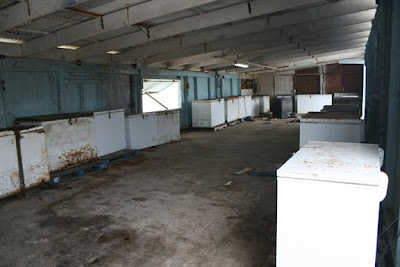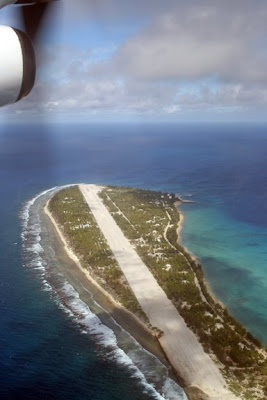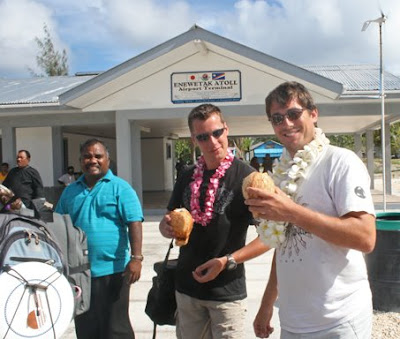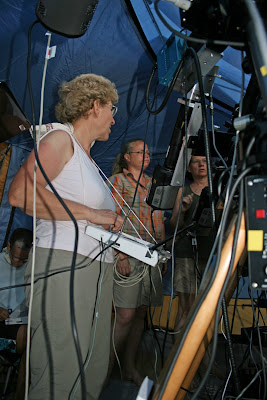Member of the Friends of the Institute for Astronomy
This report about the July 22 eclipse is especially for elementary students and teachers. You already know who Flat Stanley is. For the rest of you, he’s a storybook character who got smashed flat by a bulletin board. On the way to study the eclipse on Enewetak, the University of Hawaii Institute for Astronomy eclipse team met a second grade teacher from Oregon at the hotel on Majuro, our first stop in the Marshall Islands. (Please see entries below for descriptions of the trip and the eclipse.)
The teacher asked us to take a paper Flat Stanley with us to Enewetak and send her a report about Flat Stanley’s eclipse experience to share with her class. The following describes what Flat Stanley saw and did while he traveled with us.
A group of eighteen scientists and amateur astronomers traveled from Honolulu, Hawaii, to Enewetak Atoll in the Marshall Islands. We wanted to study the Sun during the total eclipse on July 22. An eclipse happens when the Sun, Moon, and Earth are lined up just right, and the Moon covers up the entire Sun. Then it gets dark, and you can see the Sun’s atmosphere, called the corona. It looks like a white lion’s mane. (The Earth has an atmosphere, too. It’s the air all around us.) 
During an eclipse the Moon blocks the bright light coming from the Sun, the sky gets dark, and you can see the Sun's atmosphere.
An atoll is a ring of tiny coral islands surrounding a lagoon. A lagoon is a seawater lake. It is really part of the ocean, but it has only small waves because it is protected by the islands around it. Some of the islands are large enough for people to live on, and some are not. The name Enewetak includes all the islands that make up the atoll. It is also the name of the largest island, where everyone in Enewetak lives.
Flat Stanley enjoyed swimming with us in the lagoon.
Most of the people in our group work with the University of Hawaii Institute for Astronomy. Not all of us live in Hawaii, though. Our group included people from other states, as well as people from Germany, Wales, the Czech Republic, and Slovakia. Nearly everyone spoke more than one language, so we could all talk to one another.
You have to be in just the right place to see a total eclipse. Usually the place is hard to get to. If Flat Stanley had come with our group, first he would have had to fly about five hours from Oregon to Honolulu, Hawaii. That is about the time between lunch and dinner. Then Flat Stanley would have spent the night at a hotel in Honolulu. Early the next morning, way before breakfast, Flat Stanley would have boarded another airplane and flown with our group another five hours to Majuro. Majuro Atoll is the capital of the Marshall Islands. We met the teacher from Oregon and Flat Stanley at our hotel there.
The Republic of the Marshall Islands, the country’s whole name, is across the international dateline. That means we left Honolulu on a Wednesday, but it was Thursday when we got to Majuro only five hours later. That is like going to school on a Wednesday morning and when you come back to your classroom after lunch, it is Thursday. When we returned to Honolulu, we left Majuro on a Monday night and landed in Honolulu on Sunday night, so we had two Mondays that week. Isn’t that weird?
Flat Stanley flew with us in a little airplane with two propellers for over three hours to get to Enewetak. This was the best place in the world to see the eclipse. The scientists wanted to learn more about the corona, and during an eclipse is the best time to study it. Most of what scientists have already learned has surprised them and raised more questions. (One of the most common things astronomers say is, “We didn’t expect to find that.” That is how science usually works. You get a surprising answer to one question, and then you have more questions.)
Flat Stanley and the eclipse team flew to Enewetak in this airplane.
The Sun affects our lives, and the lives of all creatures and plants on Earth, every day. Can you think of ways the Sun plays a part in your daily life? The Sun also affects astronauts and all the satellites we have circling the Earth. We need to learn all we can about the Sun and its corona. For example, we need to know more about how the Sun influences weather, here on Earth and out in space where astronauts go.
Flat Stanley helped Dr. Huw Morgan analyze the information from his experiments during the eclipse.
Flat Stanley and the amateur astronomers in our group wanted to see the eclipse. This was the first total eclipse of the Sun I ever saw. It is hard for me to think of a more awesome, spectacular, strange, and beautiful event. It was way better than watching TV. I hope I get to see many more. So does Flat Stanley. (Please see entries below for a complete description of the eclipse and photos.)
Right before and right after the Moon completely covers the Sun, Flat Stanley saw what is called the diamond ring. (Photo by Dr. Isabelle Scholl.)
The weather on Enewetak was about 95 to 100 degrees every day. One day it was 108. It was extremely humid. That means that everything always felt wet. It also rained at least once every day, usually only for ten or twenty minutes at a time. We carried Flat Stanley around in a plastic bag to keep him dry. Sometimes we took him out of the bag, but then he rolled up and became Curly Stanley.
Enewetak is different from any other place I have been. It has no stores, no restaurants, no post office, no money machines, no doctor’s office. The nearest McDonald’s is thousands of miles away. (There is not even one on Majuro.) Enewetak has no phones or faxes, no Internet, no video games, no TVs. It has only one road. You can walk across the whole island in about thirty or forty minutes.
We lived in two buildings that had bedrooms, bathrooms, a workroom, a kitchen, and a washer and dryer. An extremely loud generator provided power to run our scientific instruments, lights, and appliances. We brought a cook and our own food with us from Majuro. We could not decide whether we liked the pineapple cake or the carrot cookies best. Flat Stanley voted for the cookies.
Flat Stanley lived and worked with the eclipse team in this building.
Most of the time we were working. It took a long time to set up our instruments, get them adjusted correctly, and practice the experiments we wanted to do during the eclipse. But we also took time to read books, go swimming in the warm lagoon, toss a Frisbee, play with sand and hermit crabs, and watch lovely sunrises and sunsets. One evening we had a fly-swatting contest. The flies did not bite, but they were always buzzing around. We also had cockroaches, termites, and mosquitoes.
About 250 people live on Enewetak. They raise pigs and chickens for food, and they go fishing. Children go to elementary school on the island, but they have to go to Majuro for high school or college. Many of the people speak both Marshallese and English. They are very friendly. Nearly everyone came to greet us when our plane landed. They placed leis (flower necklaces) around our necks and gave us cold coconuts. A man with a large knife cut the tops off the coconuts so that we could drink the sweet, clear juice. It really tasted good on such a hot day.
To have fun learning about the Sun and planets, go to the I Was Wondering site. You can ask questions there, too.






























